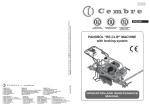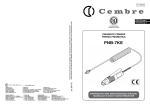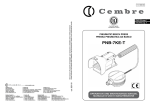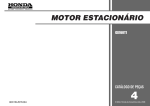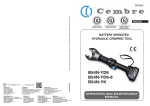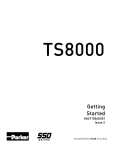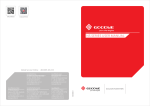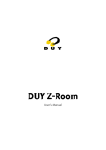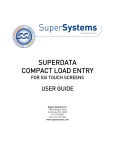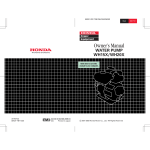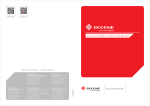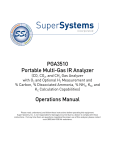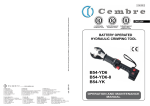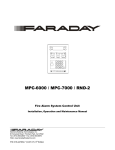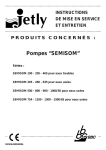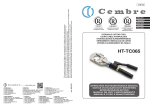Download Operation and Maintenance manual
Transcript
10 M 028 E ENGLISH Certified Quality Management System Certified Environmental Management System Certified Occupational Health & Safety Management System PANDROL "E CLIP" MACHINE with braking system OPERATION AND MAINTENANCE MANUAL 1 TG 0350 2 1 3 WARNINGS 1 Before using the machine read the instructions contained in this manual carefully. SAVE THESE INSTRUCTIONS: this manual contains important safety and operating instructions for the machine. 2 During operation keep your hands outside the danger area. 3 Always wear protective glasses and working gloves. Avoid wearing clothes which may present a risk to personal safety. Only authorised personnel shall start or operate the machine. The user shall not modify the design or configuration of the machine. Cannot be used over switches and crossings. Not to be used near live d.c. conductor rail. Not to be used for any purpose other than for which machine is designed. Do not exceed walking pace when pushing the machine. The machine fulfils the requirements of the Norm EN 13977:2005 + A1:2007. EN 13977 2 1. GENERAL CHARACTERISTICS – Application range: suitable for the insertion and extraction of Pandrol E clip* used with 75 mm bases on standard-gauge rails (1435 mm). – Developed force (single clamp) .................................................................................................... 29.000 N – Resistance between rail and wheel: ............................................................................................... ≥1 MΩ (*) "Pandrol E clip" is a Pandrol Ltd trademark. – Dimensions: .................................................................................................................. (see Fig. 17, page 26) – – – – – – Weight: complete machine: ................................................................................................................................. 112 kg pump unit: ....................................................................................................................................................50 kg clamp unit: ....................................................................................................................................................48 kg carriage: ........................................................................................................................................................... 9 kg 3rd wheel bar: ................................................................................................................................................ 5 kg – – – – – – – – – – – – – Combustion engine: type:.............................................................................................. 4-stroke, overhead valves, one cylinder model: ....................................................................................................................... Honda GX 160K1-QMD6 displacement: .........................................................................................................................................163 cm3 power: .............................................................................................................................................................. 4 kW revs.:.........................................................................................................................................................3700 rpm exhaust emissions: ...........................................HC+NOx = 10,53 gr/kW.h and CO = 433,37 gr/kW.h fuel consumption: .....................................................................................................................0.9 litres/hour fuel: .................................................................................................................unleaded regular grade petrol tank capacity: ......................................................................................................................................... 3.6 litres recommended oil: .................................................................................................... SAE 10W-30 (0.6 litres) clutch: .........................................................................................centrifugal with automatic intervention start:..................................................................................................... by rope pull with automatic rewind – – – – – Hydraulic pump: max. pressure: .......................................................................................................................................... 42 MPa oil supply: ................................................................................................................................ 5,6 litres/minute speed: .....................................................................................................................................................3700 rpm recommended oil: .......................................................................... AGIP ARNICA 32 or equivalents – Acoustic noise (Directive 2006/42/EC, annexe 1, point 1.7.4.2 letter u) – The continuous equivalent weighted level (A) of noise pressure at the working place LpA is equal to ............................................84,9 dB (A), uncertainty KpA ± 0,9 dB – The maximum value of instantaneous weighted noise pressure C at the working place LpCPeak is ................................................. ..< 130 dB (C) – The level of noise force produced by the machine LWA is equal to ..................................................... 99,6 dB (A), uncertainty KWA ± 0,9 dB – Risks due to vibration (Directive 2006/42/EC, annexe 1, point 2.2.1.1) Tests carried out in compliance with the indications contained in ISO 5439 Standard, and under operating conditions much more severe than those normally found, certify that the weighted root mean square in frequency of the acceleration the upper limbs are exposed is 3.7 m/sec2. 3 2. MACHINE DESCRIPTION (Ref. to Fig. 1) 01 02 03 04 05 06 07 08 09 10 11 12 13 14 15 16 17 18 19 20 21 22 23 24 25 26 27 28 29 30 31 32 33 34 35 36 37 38 39 40 41 42 43 44 45 – TRANSPORT HANDLES – LIFTING POINT IN NEUTRAL POSITION – HYDRAULIC PUMP OIL TANK – ACCELERATOR – WORKLIGHT ON/OFF SWITCH – STOP/EMERGENCY BUTTON – CLAMP CONTROL LEVER – HANDLEBAR – QUICK RELEASE MALE AUTOMATIC HYDRAULIC COUPLER – QUICK RELEASE FEMALE AUTOMATIC HYDRAULIC COUPLER – HYDRAULIC PUMP – PUMP UNIT FASTENING/RELEASE KNOB – WORKLIGHT – ELECTRICAL TERMINAL BOX – ENGINE – PUMP UNIT FASTENING/RELEASE KNOB – OIL COOLING RADIATOR – FRAME – CLAMP UNIT LOCATING PINS – TRANSPORT HANDLES – PUMP UNIT LOCATING PINS – QUICK RELEASE MALE AUTOMATIC HYDRAULIC COUPLER – BRAKE RELEASE DEVICE LOCK – QUICK RELEASE FEMALE AUTOMATIC HYDRAULIC COUPLER – REAR HEIGHT ADJUSTMENT KNOB – KNOB LOCK HANDLE – WHEEL LOCK/RELEASE KNOB – GAS SPRING RIGHT SIDE – TRANSPORT HANDLE – REAR WHEEL – GAS SPRING LEFT SIDE – FLEXIBLE HOSES – INSERTING/EXTRACTING TOOTH – HYDRAULIC RAM – BRAKE RELEASE DEVICE – YELLOW LOCATOR PLATE – BAR – SUPPORT WHEEL – SUPPORT WHEEL ADJUSTMENT LEVER – TRANSPORT HANDLES – CONNECTING ROD FASTENING/RELEASE KNOB – GRADUATED FRONT HEIGHT ADJUSTER – CLAMP UNIT FASTENING/RELEASE KNOBS – FRONT CARRIAGE WHEELS – BRAKE RELEASE HANDLE 4 02 03 04 05 06 45 01 07 18 08 17 PUMP UNIT 16 35 09 15 14 13 10 11 12 23 21 22 24 19 27 25 20 26 28 29 CLAMP UNIT 30 32 36 31 33 34 rd 3 WHEEL BAR 40 37 41 39 42 43 38 44 FIG. 1 - MACHINE DESCRIPTION 5 CARRIAGE 3. UNPACKING THE MACHINE (Ref. to Fig. 1) To reduce overall dimensions and weight during transport, the machine is supplied disassembled as four units. It consists of four main sections which can be easily assembled/disassembled (Ref. Fig. 1): – Pump unit: combustion engine/hydraulic pump for clamp operation. – Clamp unit: for inserting and extracting E clips. – Carriage: for supporting and moving the machine along the track. – 3rd wheel bar: for stability and vertical positioning. The machine is supplied complete with: – 1pc spark plug key. – 1litre hydraulic pump oil (do not use in engine). – 1pc 12V - 21W spare worklight bulb. 3.1) Transporting the units The four units are well balanced for easy transportation in accordance with the table and diagrams in Fig. 2. For uniform weight distribution and to transport the pump and Clamp units, always use the transportation handles provided to lift the units. Distributed Load per Person (kg) A B C D E F 24 24 9 5 25 25 A B CLAMP UNIT 6 D C CARRIAGE 3rd WHEEL BAR E F PUMP UNIT FIG. 2 – TRANSPORTING THE UNITS 4. INSTRUCTIONS FOR USE (Ref. to Fig. 4) 4.1) Assembly/disassembly of the machine Select the rail to be worked on and the direction of operation, then assemble the machine as follows, referring to Fig. 4: – With pin (27) engaged and wheel (30) blocked, raise the clamp unit by means of the handles (20 and 29) and rest this on the selected rail, positioning it between two sleepers. – Rest the support carriage on the track and then pull and turn the fastening/release knobs (43). Lift the clamp unit by means of the handle (20) and locate (19) pins fully into their carriage housing as far as the stop. Release the knobs (43) to lock the clamp unit. 1 2 7 3 – Pull and turn the knob (41), insert the 3 rd 4– 5– 6– wheel bar in the carriage housing as far as the stop, aligning the hole in the end of the rod with the pin knob. Release the knob (41) and the wheel (38) which will act as a support on the opposite rail so the assembly is stable and able to slide along the rail; the rod can be fitted in carriage from either side for convenience in selecting the direction of work. Pull and turn the knobs (12 and 16) at the base of the pump unit. Lift the pump unit by means of the handles (01) and handlebar (08). Rest the pump unit on the clamp unit and align the pins (21) with the relevant locating holes on the under side of the pump unit. Release the knobs (12 and 16) for locking. Restore the oil delivery/return hydraulic circuit, connecting the flexible hoses by means of the quick couplings (09 and 10) to the respective connectors (24 and 22) on the clamp unit. Connect the brake release device (35) (ref. to § 4.1.1) 4.1.1) Braking device (Ref. to Fig. 3a, 3b, 3c, 5) FIG. 3a To run the machine along the rail, it is necessary to connect the brake release device (35), proceed as follows: – Introduce end part (A) into slot seat (B) located above the rear wheel of the clamp unit (Ref. to Fig. 3a). – Pull the handle (C) upwards, release it in position than push until is locked (Ref. to Fig. 3b and c). – Press the handle (45) to verify the correct engagement and disengagement of release pin (P) from the wheel (Ref. to Fig. 5 and 3c). During the disassembly of the machine, before removal of the pump unit, the brake release device must be disassembled as follows: – Pull the handle (C) and disconnect the end part (A) from slot seat (B). FIG. 3b 35 A B FIG. 3c C P 8 9 38 DIRECTION OF MOVEMENT FIG. 4 – SEQUENCE OF ASSEMBLY 3 41 43 01 19 2 16 21 RAILS 1 4 20 12 21 5 22 10 27 23 24 6 09 30 35 08 29 4.1.2) Disassembly of the machine (Ref. to Fig. 4 and 4a) To disassemble the machine: – First lower the rear part and lock with pin (27), block wheel (30) then reverse the process described in § 4.1. – Before disconnecting the pump unit, make sure to have disconnected the hydraulic circuit and the braking device; locate the hoses in support (S) got on the frame of the pump unit. If necessary, with the machine fully assembled and the motor switched off, the clamps can always be opened or closed manually. NOTE: Under normal conditions, the time taken to remove the machine from the rail is approximately 60 seconds. S FIG. 4a – SUPPORT 4.2) Moving the machine (Ref. to Fig. 4b) To move the machine along the track, the rear part must be raised to prevent the clamps knocking against the E clip. To do this, simply: 1 - Pull and turn knob (27). The wheel arm will be freed. 45 2 - Slightly raise the machine by means of handlebar (08); lifting will be made easier by the two gas springs, then release the knob (27) to lock the machine fully up. 3 - Press brake release handle (45) against the 08 handlebar (08). 4 - Push the machine along the rail. 3 2 4 27 1 FIG. 4b – MOVING THE MACHINE 10 4.3) Controls (Ref. to Fig. 5) After gripping the handlebar (08), the operator can easily access all the unit controls and, more specifically: – Accelerator control lever (04): changes engine rpm. – Worklight ON/OFF switch (05): in case of night work or bad lighting, the clamping area can be illuminated by these side mounted lamps. – Stop/emergency button (06) in a very visible position and easy to operate to stop the unit normally and in case of an emergency. NOTE: when this button is pressed it remains in OFF position. To start the engine, the button should be turned clockwise so that it lifts automatically into the ON position. The engine will not start unless the red button (06) is lifted. – Clamp control lever (07) with swinging movement, for operating the clamps: - right side for inserting E clips, "INSERT" position - left side for extracting E clips, "EXTRACT" position – Brake release lever (45): for safety reasons, the machine is equipped with an automatic braking device. This device is always engaged within the rear wheel. By pressing handle (45), the brake is released enabling movement of the machine along the rail. 04 06 05 07 EXTR ACT FIG. 5 – CONTROLS 11 T INSER 08 45 4.4) Setting the machine (Ref. to Fig. 6) Before use, always check the height of the clamps with respect to the E clips. Taking a retention plate as a reference point, check the position of the clamps with respect to the plate itself. In working condition, both clamps must be: – Perfectly horizontal with respect to the rail. – The insertion/extraction tooth (33) must be able to slide horizontally with 3-4 mm clearance above the retention plate (see Fig. 6). 3 - 4 mm 33 ˜ FIG. 6 E clip retention plate To adjust, proceed as follows: 4.4.1) Adjusting the rear height of the machine (Ref. to Fig. 7) – Loosen the handle (26). – To raise the machine, turn the adjustment knob (25) clockwise. – To lower the machine, turn the adjustment knob (25) anticlockwise. – After making adjustment, tighten the handle (26) well. 25 26 FIG. 7 12 4.4.2) Adjusting the height of the front of the machine (Ref. to Fig. 8) – To raise the machine, turn the graduated adjuster (42) anticlockwise; to lower the machine, turn the graduated adjuster (42) clockwise using the graduated scale to achieve precise positioning. graduated scale 42 43 43 FIG. 8 Note: It may be easier to use the adjuster (42) with the clamp unit partially disconnected from the carriage. 4.4.3) Adjusting the vertical alignment of the machine (Ref. to Fig. 9) The distance of the teeth (33) from the retention plates of the E clips must be the same for both clamps. If this is not the case, adjust support wheel (38): – Loosen handle (39). – Lower or raise the rod (37) to change the vertical angle of the machine and achieve correct alignment. – After adjustment, tighten the handle (39) well. It may also be necessary to change the machine alignment on track bends. 38 FIG. 9 37 13 39 4.5) Operation Before use, always check: – Integrity of the machine. – The correct coupling of the units making up the machine. – Correct connection of the quick couplings and the braking device. – Correct level of oil in pump. – For any oil leaks in the hydraulic circuit (radiator, hoses, pump). – Flexible hoses are in good condition and show no signs of wear or crushing. – Protection devices in the clamp areas are firm and show no signs of damage. – That the engine fuel tank cap is tight. Petrol is highly inflammable and can explode. – Start the engine (see § 5). – With knob (27) released, push the machine to the E clips points on which operations are to be performed (see § 4.2). 4.5.1) Simultaneous insertion of 2 E clips (Ref. to Figs. 10 -11) Make sure the the locking knob (27) of the wheel is released (see § 4.2). – Position the E clips in the retention plate eyelets, on both sides of the rail. E clips FIG. 10 – Make sure the teeth (33) of the clamps are moved fully back by pulling the control lever to the left "EXTRACT". – Completely lower the machine, positioning the yellow locator plates (36) near the E clip retention plates (see Fig. 11a) 33 FIG. 11a 36 E clip retention plate 14 – Pull the control lever to the right in "INSERT" position to gradually move the teeth forwards with consequent insertion of both E clips (see Fig. 11b and 11c). When performing the insertion operation, each clamp teeth (33) will move in opposite directions. 33 FIG. 11b NOTE: During clip insertion, the movement of the teeth may NOT be simultaneous because the two clamps operate independently. 33 FIG. 11c NOTE: movement of one of the clamps is schematically shown in the illustrations; the other will have an identical and opposite movement. 33 FIG. 11d – After insertion, pull the control lever to "EXTRACT" position for teeth (33) reversal (see Fig. 11d). – Raise the machine and go onto the next E clips. – Repeat the above operations. 15 4.5.2) Simultaneous extraction of 2 E clips (Ref. to Fig.12) Make sure the locking knob (27) of the wheel is released (see § 4.2). – Make sure the teeth (33) of the clamps are moved fully forwarded by pulling the control lever to the right in "INSERT" position. – Completely lower the machine, positioning the yellow locator plates (36) near the E clip retention plates (see Fig. 12a). FIG. 12a 33 36 E clip retention plate – Pull the control lever (07) to the left in "EXTRACT" position: to gradually move the teeth forwards with consequent extraction of both E clips (see Fig. 12b and 12c). When performing the extraction operation, each clamps teeth (33) will move in opposite directions. FIG. 12b 33 NOTE: During clips extraction, the movement of the teeth may NOT be simultaneous because the two clamps operate independently. FIG. 12c 33 16 – After removal, pull the control lever to "INSERT" position for forward movement of teeth (33) (see fig. 12d). 33 – Raise the machine and go onto the next E clips. – Repeat the above operations. 17 FIG. 12d NOTE: movement of one of the clamps is schematically shown in the illustrations; the other will have an identical and opposite movement. 5. STARTING THE ENGINE – Move the stop button (06) (see § 4.3) to "ON" position (see Fig. 13a). FIG. 13a 06 The engine will not start unless the red button (06) is lifted. – Move the fuel cock to "ON" position (see Fig. 13b). – Move the air lever to "CLOSE" position (see Fig. 13b). Do not use the air lever if the engine is hot and the air temperature is high enough. FIG. 13b Air lever CLOSE OPEN – Move the accelerator control lever (04) to mid stroke (see Fig. 13c). – Start the engine by pulling the starting cable until a certain resistance is felt and then pull with force (see Fig. 13d). IMPORTANT: Do not allow the cable knob to return forcefully and knock against the engine. Return this slowly to its original position. This will prevent damage to the starting device. Fuel cock OFF ON FIG. 13c 04 – As the engine heats up, gradually move the air lever to "OPEN" position (see Fig. 13b) – Move the accelerator control lever (04) fully forward to achieve the correct rpm (see Fig. 13c). – To stop the engine in emergency condition, FIG. 13d press button (06). – To stop the engine in normal conditions: move the accelerator control lever (04) fully back. Press the button (06). Move the fuel cock to "OFF". Starting cable knob 18 TROUBLESHOOTING When the starting cable is pulled, the engine fails to start: Is the Stop/Emergency button (06) released? (see § 4.3). Is there enough oil in the combustion engine? – The engine features an oil alert system to prevent damage caused by too little oil. Before the level drops below safe limits, the alarm system automatically stops the engine. Refer to the "HONDA owner’s manual" for the type of recommended oil and topping up. THE HYDRAULIC OIL SUPPLIED WITH THE MACHINE IS INTENDED ONLY FOR USE IN THE HYDRAULIC PUMP AND IS MUST NOT BE USED IN THE ENGINE. Is the fuel stopcock open? Is there fuel in the tank? Is fuel reaching the carburettor? – To check, loosen the carburettor drainage screw with fuel cock open and refer to the "HONDA owner’s manual" . Is the spark plug producing a spark? – Remove the plug cap, clean around the plug and remove the plug using the spanner provided. – Fit the plug back in the cap. – Move button (06) to ON. – After earthing the side electrode, pull the starting cable and check to see whether the plug produces a spark. If the engine still fails to start, contact Cembre (see § 7). 19 6. MAINTENANCE All electrical and mechanical maintenance shall only be carried out by authorised persons in accordance with a safe system of work and Cembre instructions. Before servicing or removing any parts of the machine, stop the engine and allow it to cool. Always remove the spark plug cap from the spark plug when servicing the engine to prevent accidental starting. 6.1) Routine maintenance of the machine At the end of each day, clean the machine carefully using a clean cloth, being careful to eliminate all dirt or any oil stains, especially near the moving parts such as the clamp teeth and piston rods and wheels. Do not rest the machine or units directly on dusty or muddy ground. Regularly perform the following operations or inspections: – Tighten all bolts. – Check the integrity of the 3 rubber dampers which reduce vibration caused by the enginepump. – Lubricate the clamp piston rods. – If necessary change insertion/extraction teeth (33) and locator plates (36) as these become damaged or worn by prolonged or improper use. 6.1.1) Maintenance of braking device (only for versions of machine with braked wheels) The braking system is of robust construction and will require very little maintenance, however the following routine checks should be performed. Dust, sand and dirt are a danger for any mechanical device. Avoid putting the machine on muddy ground. After every use, the machine must be wiped with a clean cloth, taking care to remove any residue, especially around moving parts. Rear Carriage wheel (A): (A) 20 Before every use: – Check wheel for resistance, wheel should not be free rotating. – Ensure wheel is clean, removing any dirt or mud. – Check for signs of damage. Every 6 months: – Check for excessive braking on wheel. Wheel should roll along track when pushed, wheel will slide if excessive braking occurs. Clamp unit wheel Before every use: – Check cable, linkages, springs and wheel for signs of damage. – Check linkages are free moving. – Ensure brake cable moves without resistance. – With brake released, check that wheel rotates freely. – Check that when handlebar lever is in the raised position, the brake is engaged. – Ensure that wheel is clean of dirt and mud. – Check that, before assembly, the wheel dos not rotate one full turn in either direction. – Ensure coupling is free of dirt and mud. Every 6 months – Check wheel pockets for excessive wear. If braking effectiveness is compromised, replace wheel. – Check extension spring (see figure) on brake release handle (45) are undamaged. – Check for wear on pivots. – Ensure fasteners are secure. – Check for wear on coupling, parts should mate securely. – Clean all moving parts and lubricate as required. extension spring 45 21 6.1.2) Topping up the oil in the hydraulic pump (Ref. to Fig. 14a) Periodically check the level of the oil in the hydraulic pump. The oil should always be visible inside the 03 tank (03). If the level is low, top up with the specific oil recommended: – Unscrew the cap and add sufficient oil to fill the tank; do not exceed the oil level. – After topping up, tightly screw the cap back on. Always use clean recommended oil, see § 1. Do not use old or recycled oil. Do not use hydraulic brake fluid. FIG. 14a 6.1.3) Changing worklight bulbs (Ref. to Fig. 14b-d) – Loosen the locking nut (Fig. 14b). – Turn worklight upwards and remove the two locking screws in the lens (Fig. 14c) using a screwdriver. nut – Remove the faulty bulb and replace with another having the same specifications: 12V - 21W – Replace lens and tighten the two screws. – Reset worklight to original position and tighten the nut. The light bulb power circuit is protected by a fuse against overcurrents and short-circuits. In case of a fault: – Remove the 4 screws from the lid of the terminal box (14) using a screwdriver. FIG. 14b – Pull out fuse carrier and open it (Fig. 14d). – Replace faulty fuse with a new one with the same specifications: 6,3A - 250V – Push fuse carrier back, replace lid and tighten 4 screws. light bulb 12V - 21W 14 fuse-carrier FIG. 14d FIG. 14c 22 6.1.4) Changing the gas springs (Ref. to Fig. 15) Replace the gas springs when required as follows: – Release the wheel arm so the springs are in extended position. – Using a flat-blade screwdriver, lift the retention collar at the end of the spring, pulling with force at the same time to release the spring from its locating pins. – Fit the new spring on the same pins and press with force until this is properly fitted in the original position. gas spring screwdriver Note: the two springs differ from one another. FIG. 15 6.1.5) Maximum pressure valve (Ref. to Fig. 16) The hydraulic pump features a maximum pressure valve, factory set and sealed at 42 Mpa. Maximum pressure valve NEVER CHANGE THE MAXIMUM P R E S S U R E VA LV E S E T T I N G A S THIS MAY CAUSE SERIOUS DAMAGE TO THE MACHINE. To check correct valve setting, a special pressure testing gauge is available (Ref. to § 8). 6.2) Routine maintenance of the engine FIG. 16 Checks and periodical assistance are indispensable to ensure smooth engine operation. Refer to the "Honda user's manual" supplied with the machine, for the following operations: – Oil change – Air filter assistance (see double-element type) – Cleaning sediments from sump – Spark plug cleaning; recommended plugs BPR6ES (NGK) or W20EPR-U (DENSE) – Minimum carburettor setting 6.3) Long periods of inactivity – Store the machine in a dry environment, and adequately protect it against accidental damage and contamination. – For information on the combustion engine, refer to the "HONDA user's manual". 23 24 Braking device & wheels Gas springs Light bulbs and fuse Hydraulic oil Inserting teeth (33) Locator plate (36) Rubber dampers of the machine Hydraulic couplers Flexible hose Bolts and nuts Complete machine ITEM Visual & manual checks of integrity Replacement Replacement Check reservoir level (Top up if necessary) Replacement Visual & manual checks of integrity Replacement Visual & manual checks of integrity Complete tightening Visual & manual checks (tighten if necessary) Visual check of integrity Replacement Complete tightening Visual & manual checks of (tighten if necessary) Store the machine in dry place protecting it from shocks and dust General cleaning with a clean cloth, paying attention to remove settled dirt ACTION Performed at the prescribed intervals or at the number of indicated working hours or at the occurrence of indicated extraordinary events PERIODIC OVERHAUL At every use 50 hours Ref. to § 6.1.1 Presence of evident signs of wear In case of breakage Long periods of inactivity 7. RETURN TO Cembre FOR OVERHAUL In the case of a breakdown contact our Area Agent who will advise you on the problem and give you the necessary instructions on how to dispatch the machine to our nearest service Centre; if possible, attach a copy of the Test Certificate supplied by Cembre together with the machine or, if no other references are available, indicate the approximate purchase date and machine serial number. 8. OPTIONAL ACCESSORIES - MPC6 PRESSURE GAUGE code 2595209 To check maximum pressure valve setting. - PROTECTIVE COVER FOR PANDROL CLIP MACHINE: TARPCOVER 019-PCM code 2593275 (material: Polyethylene HDPE UV stabilised, + 70 °C to - 40 °C) 25 850 1400 xxxxxx Clamp unit serial nr. 26 xxxxxx Pump unit serial nr. 650 1000 max. 1900 FIG. 17 – DIMENSIONS (mm) 27 This manual is the property of Cembre: any reproduction is forbidden without written permission. Cembre reserve the right to modify the specifications in this manual without prior notice. Cembre S.p.A. Via Serenissima, 9 25135 Brescia (Italia) Telefono: 030 36921 Telefax: 030 3365766 E-mail: [email protected] www.cembre.it Cembre España S.L. Calle Verano, 6 y 8 - P.I. Las Monjas 28850 Torrejón de Ardoz - Madrid (España) Teléfono: 91 4852580 Telefax: 91 4852581 E-mail: [email protected] www.cembre.es Cembre Ltd. Dunton Park Kingsbury Road, Curdworth - Sutton Coldfield West Midlands B76 9EB (Great Britain) Tel.: 01675 470440 - Fax: 01675 470220 E-mail: [email protected] www.cembre.co.uk Cembre AS Fossnes Senter N-3160 Stokke (Norway) Phone: (47) 33361765 Telefax: (47) 33361766 E-mail: [email protected] www.cembre.no Cembre S.a.r.l. 22 Avenue Ferdinand de Lesseps 91420 Morangis (France) Tél.: 01 60 49 11 90 - Fax: 01 60 49 29 10 B.P. 37 - 91421 Morangis Cédex E-mail: [email protected] www.cembre.fr Cembre GmbH Heidemannstraße 166 80939 München (Deutschland) Telefon: 089/3580676 Telefax: 089/35806777 E-mail: [email protected] www.cembre.de cod. 6261357 www.cembre.com Cembre Inc. Raritan Center Business Park 181 Fieldcrest Avenue Edison, New Jersey 08837 (USA) Tel.: (732) 225-7415 - Fax: (732) 225-7414 E-mail: [email protected] www.cembreinc.com 28




























